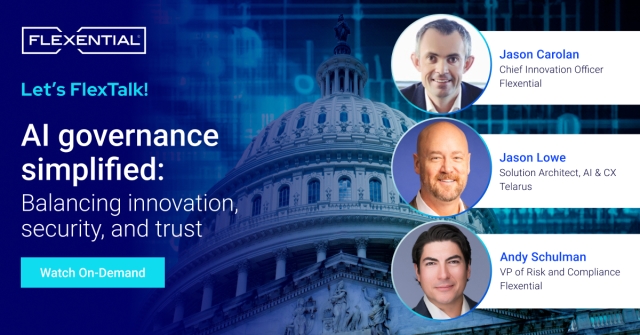Simplifying AI governance
A blueprint for balancing trust and transformation
Learn how to simplify AI governance by balancing innovation, security, and trust. Discover expert strategies for risk management, compliance, hybrid deployment, and building transparency into your AI initiatives.

As AI continues to evolve at breakneck speed, organizations face a mounting challenge: how to harness its transformative potential while safeguarding security, ensuring compliance, and maintaining stakeholder trust. Our FlexTalk webinar, AI Governance Simplified: Balancing Innovation, Security, and Trust, brought together industry experts from Flexential and Telarus to demystify these concerns and provide a practical roadmap for responsible AI adoption.
Whether you're an IT leader, a compliance executive, or a business strategist, here’s what you need to know to simplify AI governance in your organization.
Why AI governance matters now more than ever
AI is no longer experimental—it's operational. From customer experience tools and fraud detection to predictive analytics and internal compliance automation, enterprises are integrating AI into core business functions.
But with great power comes great responsibility.
AI systems depend on massive datasets, often sensitive in nature. Improper handling can lead to compliance failures, breaches of privacy, and even unintentional bias. The solution? Establishing a governance framework that balances innovation with accountability.
“I think we're […] in that early to mid-stage of AI maturity progression. I see larger adoption by companies that actually can devote a ton of resources to it—they're able to get themselves ahead. But where a lot of people are having problems is in mid-market and smaller enterprise companies where you're dealing with a pretty big skills gap, and you're dealing with a lot of things that are inhibiting their adoption.”
— Jason Lowe, Solution Architect for AI & CX at Telarus
Key pillars of simplified AI governance
1. Build a strategic governance roadmap
“Make sure that you have an overall strategic road map that is a living document for the company that can be flexed based on feedback or technology advancements.”
— Jason Lowe, Solution Architect for AI & CX at Telarus
Governance must be intentional, not reactive. An AI strategy roadmap should:
- Define clear objectives for short-, mid-, and long-term AI adoption across departments.
- Incorporate compliance readiness and risk assessment checkpoints at every deployment phase.
- Designate cross-functional roles and responsibilities across IT, legal, compliance, and business units.
- Account for cultural shifts with plans for workforce upskilling, change management, and stakeholder alignment.
- Include review mechanisms that allow for agility as regulations evolve and technologies advance.
2. Secure and compliant AI deployment
Security and compliance must be built into AI systems—not bolted on later. Key practices include:
- Perform rigorous vendor assessments, including AI-specific due diligence questionnaires.
- Incorporate AI-related terms into legal contracts, ensuring opt-in capabilities for any AI features.
- Establish controls for data flow and storage, especially in multi-tenant or cross-border architectures.
- Choose hybrid deployment models that keep sensitive data on-prem while leveraging cloud scalability.
- Implement governance controls for shadow AI, preventing unauthorized use of embedded features in SaaS platforms.
“Having a very clear understanding of what your data protection and privacy requirements are as an organization is very critical to going into some of these adoption decisions with eyes wide open because it does get complicated pretty quickly, especially when you start linking together 3rd and 4th party type relationships.”
—Andy Schulman, VP of Risk and Compliance at Flexential
3. Adopt hybrid and explainable AI architectures
“Shadow AI is real. Tools are being embedded in platforms without clear documentation, leaving enterprises exposed without even realizing it.”
— Jason Carolan, Chief Innovation Officer, Flexential
A hybrid AI deployment model—where sensitive data is kept on-prem while leveraging cloud compute for scalability—is emerging as a best practice. It provides both performance and control.
Explainability is also critical. Stakeholders need to understand how AI makes a decision. Implementing explainable AI (XAI) techniques supports ethical use, builds trust, and is becoming necessary for compliance.
“You can’t trust what you can’t see. That’s why explainable AI and transparency aren’t optional—they’re foundational to responsible adoption.”
—Andy Schulman, VP of Risk and Compliance at Flexential
4. Prepare for the rise of AI oversight roles
As AI becomes deeply embedded in business operations, more organizations are considering roles like the Chief Artificial Intelligence Officer (CAIO). This role could centralize AI strategy, monitor compliance, and align technical innovation with business risk.
“There are a lot of companies that are looking to take the oversight of what's going on with artificial intelligence within their company a little bit more seriously. So […] I think the incremental chief artificial intelligence officer is really going to take off just as much as the virtual CSO did.”
— Jason Lowe, Solution Architect for AI & CX at Telarus
5. Educate and empower your workforce
Policy alone won’t solve misuse. Education must be a cornerstone of your governance plan. From ethical guidelines to hands-on training, organizations must upskill teams across IT, legal, marketing, and operations to use AI responsibly and effectively.
“Deloitte had a survey where they talked about nearly 70% of companies are recognizing that they are going to have to go outside for specialized expertise to manage AI complexities and adoption—and this includes governance and cybersecurity.
— Jason Lowe, Solution Architect for AI & CX at Telarus
Looking ahead: The future of AI governance
Emerging technologies like edge computing and blockchain are poised to reshape AI governance. Processing data closer to the source enhances control and reduces risk, while blockchain offers transparent, tamper-proof logs for AI decision-making—like a "nutrition label" for AI.
Additionally, AI itself will help govern AI. Expect to see AI-driven compliance tools validating the integrity and legality of other models—essentially, AI auditing AI.
Take action: Governance is a competitive advantage
“We get so lost in the technology that we're not paying enough attention to. What's the impact within our walls on the actual human beings who are doing this work, and how is that going to happen in the future? Does that lead to additional training and upskilling in other areas? Does that lead to meetings to make sure people are comfortable with the technology and know how to use it? Training is going to be a big deal.”
— Jason Lowe, Solution Architect for AI & CX at Telarus
Organizations that act now will not only reduce risk—they’ll lead the way in innovation. Start by:
- Launching an internal task force or AI governance committee to drive alignment and set strategic priorities.
- Piloting explainable AI tools to assess model behavior and improve transparency in decision-making.
- Collaborating with partners and vendors who are willing to share their model validation methods and governance practices.
- Investing in employee education around responsible AI usage, privacy considerations, and ethical implications.
- Turning governance into a value prop, demonstrating to customers and stakeholders how your organization takes AI seriously and securely.
Final thoughts
AI governance isn’t just about mitigating risk—it’s about enabling innovation in a secure, ethical, and scalable way. From strategy roadmaps and explainability to vendor oversight and hybrid deployments, organizations must take a proactive stance to stay ahead in a rapidly evolving landscape. The time to act is now.
Want to hear directly from the experts and dive deeper into each of these strategies? Watch the full webinar on-demand for a comprehensive, real-world look at simplifying AI governance, or download the AI Governance Playbook.








